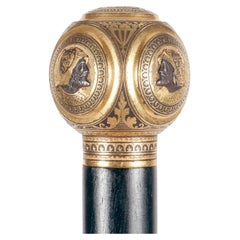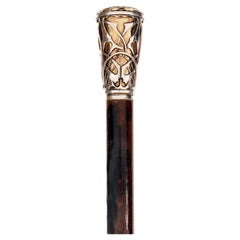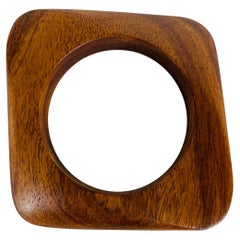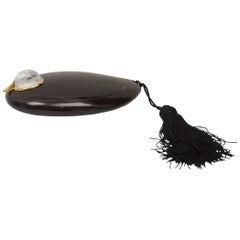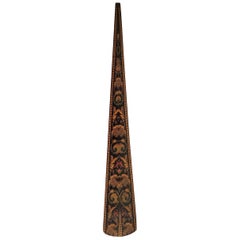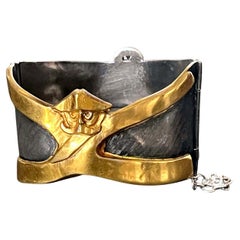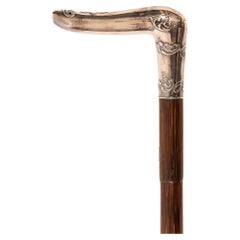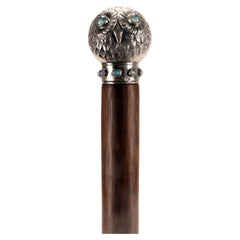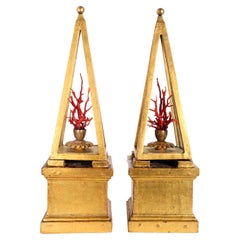Hardwood Collectible Jewelry
to
3
2
5
1
2
3
1
1
1
1
57,828
1,457
638
406
325
4
1
1
1
1
5
5
5
1
Material: Hardwood
Jewel walking stick, representing 5 cameos, Russia 1880.
Located in Milan, IT
Walking stick: jewel walking stick, round iron knob, with engraved gold parts, depicting 5 cameos. Macassar wood cane. Brass and iron ferrule. Russia circa 1880.
Category
Late 19th Century Russian Antique Hardwood Collectible Jewelry
Materials
Gold, Brass, Iron
jewel walking stick with Charlotte monogram, by Philippe Wolfers, Belgium 1900.
Located in Milan, IT
Walking stick: Art Nouveau jeweled walking stick, gold and silver milord knob with intertwined CHARLOTTE monogram. Fruitwood shaft. Light bovine horn ferrule. Signed Philippe Wolfers...
Category
Early 20th Century Belgian Hardwood Collectible Jewelry
Materials
Gold, Silver
Catherine Noll teak bracelet, french jewelry
By Catherine Noll
Located in BELFORT, FR
Rare Catherine Noll bracelet.
Measurements : 9,5 cm x 9 cm / diagonals 11,5 cm x 11,5 cm / inner diameter 6,3 cm
"Granddaughter of sculptor Alexandre Noll, Catherine Noll loved sh...
Category
1970s French Vintage Hardwood Collectible Jewelry
Materials
Wood, Teak
Emanuele Pantanella Minaudiere in Carved Ebony, Rock Crystal and 18-Carat Gold
Located in Hudson, NY
A fine and exquisite example of the designers work. The bag is signed and numbered 0089. Known for his elegant refinement the designer was born in 1939 and passed in 2014. Working in Rome and fully understanding the Mediterranean love of pure refinement his designs express a sublime play of luxury with simplicity. These small clutches are in demand the world over. Examples of his work can be found carried by the best-dressed women from the highest levels of society and in institutional collects such as the Metropolitan Museum of Art in New York, the Victoria & Albert Museum in London as well as a long list of other international museums and institutions too numerous to mention. Crafted completely by hand in Italy these are like fine small sculptures with no two being alike. The gems and stones used are examples of the lapidary art...
Category
Mid-20th Century Italian Hardwood Collectible Jewelry
Materials
Rock Crystal, Gold
Rare 19th Century English Tunbridgeware Hair Pin or Slide
Located in Dallas, TX
PRESENTING an EXTREMELY UNIQUE and RARE 19C British Tunbridgeware Hair Pin/Bobbin or Slide.
This slide is unlike any of it’s kind we have seen before, it is a VERY RARE survivor.
From circa 1860 – 80 and made in Tunbridge Wells, England.
Made of walnut with gorgeous marquetry inlay on the entirety of the front with classic Tunbridgeware micro-mosaic all over the front. The rear is walnut.
The marquetry inlay appears to be various different woods, namely, maple, walnut and satinwood.
Would have been worn in a Lady’s hair bun with the micro-mosaic facing forward.
This would have belonged to a VERY ELEGANT LADY in the mid to late 19th Century.
Tunbridge ware is a form of decoratively inlaid woodwork, typically in the form of boxes, that is characteristic of Tonbridge and the spa town of Royal Tunbridge Wells in Kent in the 18th and 19th centuries. The decoration typically consists of a mosaic of many very small pieces of different coloured woods that form a pictorial vignette. Shaped rods and slivers of wood were first carefully glued together, then cut into many thin slices of identical pictorial veneer with a fine saw. Elaborately striped and feathered bandings for framing were pre-formed in a similar fashion.
There is a collection of Tunbridge ware in the Tunbridge Wells Museum and Art Gallery in Tunbridge Wells.
The famous makers of Tunbridge ware were in the Tunbridge Wells area of Kent; their most notable work was from circa 1830-1900.
Early makers of Tunbridge ware, in Tunbridge Wells in the mid-18th century, were the Burrows family, and Fenner and Co. In the 19th century, around 1830, James Burrows invented a technique of creating mosaics from wooden tesserae. Henry Hollamby, apprenticed to the Burrows family, set up on his own in 1842 and became an important manufacturer of Tunbridge ware, employing about 40 people.
Edmund Nye (1797–1863) and his father took over the Fenner company when William Fenner retired in 1840, after 30 years in partnership with him. Thomas Barton (1819–1903), previously apprenticed at the Wise factory, joined the Nyes in 1836, and worked as Nye’s designer; he took over the business in 1863 and continued there until his death.
In Tonbridge (near to Tunbridge Wells), George Wise (1703–1779) is known to have had a business in 1746. It continued with his son Thomas, and Thomas’s nephew George (1779–1869), who took over in 1806. In its early years the company made articles such as workboxes and tea caddies with prints of popular views; later items had pictures created from mosaics. Their workshop in Tonbridge, Wise’s Tunbridge Ware Manufactory, was next to the Big Bridge over the Medway; the building was demolished in 1886 to widen the approach to the bridge.
Tunbridge ware became popular with visitors to the spa town of Tunbridge Wells, who bought them as souvenirs and gifts. Articles included cribbage boards, paperweights, writing slopes, snuffboxes and glove boxes.
At the Great Exhibition of 1851, Tunbridge ware by Edmund Nye, Robert Russell and Henry Hollamby was shown; Edmund Nye received a commendation from the judges for his work. He exhibited a table depicting a mosaic of a ship at sea; 110,800 tesserae were used in making the picture.
The manufacturers of Tunbridge ware were cottage industries, and they were no more than nine in Tunbridge Wells and one in Tonbridge. The number declined in the 1880s; competent craftsmen were hard to find, and public tastes changed. After the death of Thomas Barton in 1903 the only surviving firm was Boyce, Brown and Kemp, which closed in 1927.
Marquetry was an old technique which was continued by Nye and Barton to create images such as birds or butterflies.
‘Green Oak’ as caused by the fungus Chlorociboria aeruginascens.
Stickware and half-square mosaic was invented by James Burrows in about 1830: a bunch of wooden sticks of different colours, each having triangular or diamond-shaped cross section, were tightly glued together; in the case of stickware, the resulting block was dried, then turned to form an article such as the base of a pincushion. For half-square mosaic, thin slices were taken from the composite block, and applied to a surface.
Tesselated mosaic, was a development by James Burrows of half-square mosaic; it was adopted by George Wise and Edmund Nye. Minute tesserae were used to form a wide variety of geometric and pictorial designs.
Many sorts of wood were used for the various colours; about 40 were in regular use. Only natural colors were used; green was provided by “green oak”, produced by the action of fungus on fallen oak. Designs for articles were often taken from designs of Berlin wool work.
Category
Late 19th Century English High Victorian Antique Hardwood Collectible Jewelry
Materials
Satinwood, Walnut
Related Items
French Art Bronze Bracelet by Line Vautrin
By Line Vautrin
Located in Atlanta, GA
A rare cuff bracelet in gilded and silvered bronze by Parisian art jewller Line Vautrin (1913-1997). The playful piece is called "Le gendarme et le voleur"...
Category
1940s French Mid-Century Modern Vintage Hardwood Collectible Jewelry
Materials
Bronze
Antique Walking Stick with Silver Handle
Located in Alessandria, Piemonte
Antique walking stick with silver handle: may be French, from the early twentieth or late nineteenth century.
It's very elegant functional.
ref. O/7571
Category
Early 20th Century French Art Nouveau Hardwood Collectible Jewelry
Materials
Silver
Vintage 18K Carved Rock Crystal, Jade and Diamond Lily of the Valley Clip Brooch
Located in Norwood, NJ
A lovely 18K yellow gold vintage floral brooch realistically modeled as lily of the valley, set with frosted carved rock crystal flowers, each suspending a sparkling full round cut diamond, mounted on an 18k yellow gold stem and a carved jade leaf...
Category
Early 20th Century Austrian Hardwood Collectible Jewelry
Materials
Jade, Rock Crystal, Gold
$2,875
H 2.27 in W 0.83 in D 0.79 in
1960s Replica Greg Noll Black Walnut Trophy Surfboard
By Greg Noll
Located in Haleiwa, HI
Late-1960s replica Greg Noll Surf Center Hawaii wooden surfboard. Features a transitional-era (late 1960’s style) pintail shape made with one of the rarest a...
Category
2010s American Hardwood Collectible Jewelry
Materials
Fiberglass, Hardwood
Rare 19th Century Meerschaum Pipe – Bullfight Scene
Located in Madrid, ES
Exceptional and rare 19th century meerschaum pipe, finely carved, depicting a detailed bullfight scene. The composition depicts a dramatic moment where one bullfighter is assisted by...
Category
19th Century Spanish Other Antique Hardwood Collectible Jewelry
Materials
Organic Material
Late 19th Century English Diorama Clipper Ship Shadowbox
Located in Queens, NY
Late 19th century English Victorian painted diorama wall plaque of clipper ship with red flag painted in cloudy sky in mahogany frame.
Category
Late 19th Century British Victorian Antique Hardwood Collectible Jewelry
Materials
Mahogany
Rock Crystal Column
Located in New York, NY
Carved rock crystal column:
Measures: 3.25" x 3.25" x 11".
Category
21st Century and Contemporary Hardwood Collectible Jewelry
Materials
Rock Crystal
Chinese Export Sterling Silver Walking Stick Handle, circa 1900
Located in Chapel Hill, NC
Chinese Export sterling silver walking stick handle, circa 1900. Monogram of the famous ichthyologist Dr. Hugh McCormick Smith, "H...
Category
Early 20th Century Chinese Chinese Export Hardwood Collectible Jewelry
Materials
Silver
$180 Sale Price
20% Off
H 0.75 in W 2.75 in D 4.38 in
Antique Vintage Lady's Gentleman's Walking Dress Stick Cane English Bulldog 1900
Located in Dublin, Ireland
Stylish Solid Polished Honey Coloured Malacca Wood Lady’s or Gentlemans Walking Stick Dress Cane with Traditional formed Tau shaped handle in Art Nouveau style, possibly of French or...
Category
Late 19th Century British Edwardian Antique Hardwood Collectible Jewelry
Materials
Hardwood
$448
H 35 in W 4.25 in D 4.25 in
Natural Rock Crystal Specimen Piece
Located in New York, NY
A rock crystal natural specimen piece aka clear quartz, decorative object. Dimensions: 3.5" D x 4.25" W.
Marble plinth shown available separately, search 1stDibs ref. #: LU13142392...
Category
20th Century Unknown Organic Modern Hardwood Collectible Jewelry
Materials
Quartz, Rock Crystal
Antique French 19th Century Jewelry Box Flap Door Miniature Wood Cabinet
Located in Firenze, IT
This beautiful French late 19th century chest of drawers in black ebonized wood and cherrywood reproduces with perfect proportions in scale a miniature cabinet with three drawers and an upper flap door that opens to reveal a white marble top and an oval mirror inside, nice hand carved band on top with geometrical pattern and molded base.
The black lacquered wood creates a wonderful contrast with the beautiful honey-colored wood grain. Despite its convenient size, extremely detailed, this chest of drawers is equipped with a white Carrara marble top and a small mirror that make it even more special and useful.
The model of a piece of furniture was originally created by cabinet makers to show their skills to the customer and to present the sample of the furniture which would then have been produced on a larger scale. These commode miniatures, along with other specimens, were displayed in the craftsman's workshop to serve as examples to aid the potential client in making a selection. Some also think that these little chests were used as doll and puppets...
Category
Late 19th Century French Empire Antique Hardwood Collectible Jewelry
Materials
Carrara Marble, Metal
$1,651
H 11.03 in W 10.24 in D 6.7 in
Mid-Century Modern Hand Carved Pink Rock Crystal Catchall Bowl Vide Poche, 1970
Located in Miami, FL
Mid-Century Modern pink and white Mineral Rock ashtray, catchall, vide poche or bowl made in Italy.
Raw Rock Crystal hand carved in a geometric shape.
Great as Ring Dish or Key Bowl...
Category
1970s Italian Mid-Century Modern Vintage Hardwood Collectible Jewelry
Materials
Rock Crystal
$395
H 1.5 in W 6 in D 5 in
Previously Available Items
Walking stick, handle depicting an owl’s head, Prague 1900.
Located in Milan, IT
Walking stick: round knob made of 800/1000 silver metal, embossed workmanship, depicting the head of an owl. Collar and eyes with opal stones, cabochon cut. A monogram is engraved on...
Category
Early 20th Century Czech Hardwood Collectible Jewelry
Materials
Silver
Pair of Obelisks with Branches of Mediterranean Red Coral, Italy 1700
Located in Milan, IT
Pair of Wunderkammer display cases, two obelisks with branches of Mediterranean red coral (Corallium Rubrum).
The pair is made of fruit wood, carved, illuminated and gilded.
The ba...
Category
Early 18th Century Italian Antique Hardwood Collectible Jewelry
Materials
Coral
1920s Antique Hamilton Fahys 972 Railroad Pocket Watch 17 Jewels Dome Display
By Hamilton
Located in Dayton, OH
Antique 1920s mechanical pocket watch by Hamilton Watch Company of Lancaster, PA, featuring a gold case with fluted sides and a shield design on the back; Fahys case serial number 81...
Category
1920s Edwardian Vintage Hardwood Collectible Jewelry
Materials
Metal
Antique 1850s Open Face Remontoir 800 Silver Pocket Watch 10 Rubis Glass Display
Located in Dayton, OH
Antique mid 19th century open face remontoir pocket watch. A remontoir (french: remonter – 'to wind') is a pocket watch in which the key winding...
Category
Mid-19th Century Victorian Antique Hardwood Collectible Jewelry
Materials
Brass
Natural Specimen, a Branch of Red Coral, Italy, 1870
Located in Milan, IT
A specimen of Naturalia from the Wunderkammer. Red Mediterranean coral branch (Coralium rubrum), mounted on a wooden base, palm holder in the shape of a white lacquered vase...
Category
1870s Italian Antique Hardwood Collectible Jewelry
Materials
Coral
Antique Sterling Handled Walking Stick or Cane with Figural Snake or Serpent
Located in Hamilton, Ontario
This antique and very well executed sterling silver handled walking stick or cane is unsigned, but presumed to have originated from the Uni...
Category
Late 19th Century American Late Victorian Antique Hardwood Collectible Jewelry
Materials
Sterling Silver
H 33.5 in W 2 in D 5.5 in
Natural Specimen, a Crystals of Colecite and Pyrite, Italy 1880
Located in Milan, IT
A Natural mineral specimen for Wunderkammer. A composition of crystals of Colacite and pyrite, mounted over gold-plated wooden bases shape of vase. Italy 1880 ca.
Category
1870s Italian Antique Hardwood Collectible Jewelry
Materials
Crystal, Quartz, Rock Crystal, Pyrite
Natural Specimen a Pair of Druzes with Crystals, Italy, 1880
Located in Milan, IT
A natural mineral specimen for Wunderkammer. A pair of Apophyllite and white quartz druzes, mounted over carved wooden base, vase shape with l...
Category
1870s Italian Antique Hardwood Collectible Jewelry
Materials
Crystal, Quartz, Rock Crystal
Natural Specimen White Quartz and Rock Crystals, Italy, 1880
Located in Milan, IT
A Naturali specimen for Wunderkammer. A druze of Rock crystals and white Quartz with Baryte crystals mounted over a carved wooden base, gold gilt on a shape of a vase. Italy, 1880 ca.
Category
1870s Italian Antique Hardwood Collectible Jewelry
Materials
Crystal, Quartz, Rock Crystal
Natural Specimen Amethyst and Calcite Flowers Crystals, Italy, 1880
Located in Milan, IT
A Naturalia mineral specimen. A druze of Amethyst, colacite stones and calcite flowers crystals, mounted over a guild-plated wooden base on a vase shape. Italy 1880 ca.
Category
1870s Italian Antique Hardwood Collectible Jewelry
Materials
Stone, Amethyst
Antique Victorian Hand Carved Silhouette Cameo Shell Oval Wall Plaque
Located in Dayton, OH
Intricately carved antique natural shall cameo displayed in a small wood wall plaque, sold by Closson’s Art Gallery of Cincinnati.
Measures: 3.5” x 0.75” x 2.5” / Cameo - 1.875” x...
Category
Late 19th Century Victorian Antique Hardwood Collectible Jewelry
Materials
Shell, Hardwood
Natural Specimen a Pair of Quartz and Vanadinite Crystals, Italy, 1880
Located in Milan, IT
A Naturalia mineral specimen. A pair of Vanadinite and quartz crystals mounted over carved gold gilded and lacquered wooden base, white-beje color. Italy 1880 ca.
Category
1870s Italian Antique Hardwood Collectible Jewelry
Materials
Crystal, Rock Crystal
Recently Viewed
View AllMore Ways To Browse
Shiwan Ware
Silk Umbrella
Silver Bridge Box
Silver Etagere
Silver Leaf Display Cabinets
Silvered Metal Pineapple
Sleeping Cupid
Small French Drop Leaf Tables
Sovereign Case
Spanish Amphora
Spanish Colonial Shelf
Staffordshire Scottish
Standing Buddhas
Steuben Glass Vase Vintage
Stone Buddha Head
Store Counter Island
Swedish Baroque Chest
Swedish Dressing Table
